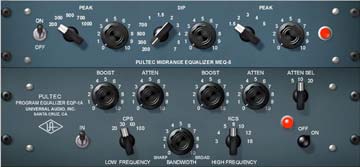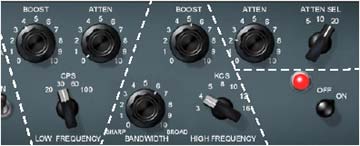Analog Obsession: The Pultec Family
 |
|
The new Pultec-Pro plug-in combines the
Pultec EQP-1A and MEQ-5 |
UA’s new Pultec-Pro Combines the two most widely used Pultec EQs; the EQP-1A Program Equalizer, and the MEQ-5 Mid Band Equalizer, which when used together, give the user a well-rounded EQ palette. This combination is still standard fare in recording studios and was once widely used in mastering sessions.
History
In 1951, Pultec introduced the first passive program equalizer, the EQP-1. The EQP would see many iterations, but this basic design would be the company’s flagship product until the company’s folding in the late 70’s/early 80’s. The company was neither bought nor sold; Pultec simply closed its doors.
 |
|
The original EQP-1A program Equalizer
|
An interesting note in the Pultec design legacy, the passive EQ circuit designs were licensed from Western Electric. Pultec combined the passive design with a tube gain make amp to overcome the typical 16 dB insertion loss of a passive equalizer. So this made the Pultec appear to be "lossless."
 |
|
Original MEQ-5 Midband EQ
|
The build quality and design of all the Pultec products was unparalleled. A testimony to this is the numerous working units still available in the audio production world. It is said the men were very secretive about their designs, and very few were ever allowed to visit the facility. In addition to the famous tube EQ’s, Pultec also made solid-state versions of these units, which were the silver-face variety. Perhaps less known, Pultec made filters, small mixers and preamps, one of the most intriguing products being the MAVEC, an early “channel strip” that included a mic-pre, eq, and simple compression all in a 2U rack mount design.
In Use
The Pultecs are known as magical tools that improve the sound of audio simply by passing signal through them; by who wants to leave it at that? The Pultecs have long been a choice of recording and mastering engineers for their ability to bring out individual frequency ranges without significantly altering other frequencies; so extreme settings are no problem with the Pultecs.
If you’ve never used a Pultec EQP-1A, the grouping of controls might be a little confusing. The EQP-1A can control three frequency ranges simultaneously, using three groups of interacting controls.
 Control grouping within the Pultec EQP-1A |
|
In the documentation supplied with hardware version of the EQP-1A, it is recommended that both Boost and Attenuation not be applied simultaneously to the low frequencies because in theory, they would cancel each other out. In actual use however, the Boost control has slightly higher gain than the Attenuation has cut, and the frequencies they affect are slightly different. The EQ curve that results when boost and attenuation are simultaneously applied to the low shelf is difficult to describe, but very cool: Perhaps the sonic equivalent of a subtle low-midrange scoop, which can add clarity. A great trick for kick drums and bass instruments.
With the MEQ-5, handy upper and lower midrange frequencies are now accessible for boosting, as well as the highly useful midrange parametric cut.
Straightforward in operation, the MEQ-5 is divided into three groups of controls.
All groups are fixed Q parametric. In general the Q is medium, but can be subtlety different depending on the frequency selected in each band. Total boost or cut range is 10 dB.
 Control grouping within the Pultec MEQ-5 |
|
-Will Shanks
Special Thanks to Irv Joel and Paul McManus